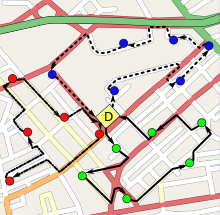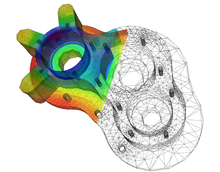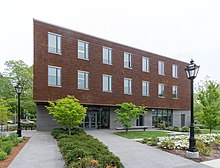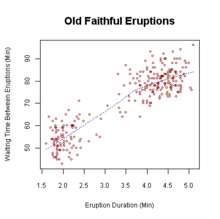Applied mathematics

응용 수학은 물리학(physics), 공학(engineering), 의학(medicine), 생물학(biology), 금융(finance), 영업(business), 컴퓨터 과학(computer science), 및 산업(industry)과 같은 다양한 분야에 의한 수학적 방법(mathematical method)의 응용입니다. 따라서, 응용 수학은 수학적 과학(mathematical science)과 전문화된 지식의 조합입니다. 용어 "응용 수학"은 역시 수학자들이 수학적 모델을 공식화하고 연구함으로써 실용적인 문제를 해결하는 전문 분야(professional specialty)를 나타냅니다.
과거에, 실용적인 응용이 수학적 이론의 발전에 동기를 부여해 왔으며, 그런-다음 추상적인 개념은 그것 자체를 위해 연구되는 순수 수학(pure mathematics)에서 연구 주제가 되었습니다. 응용 수학의 활동은 따라서 순수 수학에서 연구와 밀접하게 연결되어 있습니다.
History

역사적으로, 응용 수학은 주로 응용 해석학(applied analysis), 특히 미분 방정식(differential equations); 근사 이론(approximation theory) (표현(representation), 점근적(asymptotic) 방법, 변화의 방법(variational methods), 및 수치 해석(numerical analysis)을 포함하기 위해 넓은 의미로 해석됨); 및 응용 확률(probability)로 구성됩니다. 이들 수학의 영역은 뉴턴 물리학(Newtonian physics)의 발전과 직접적으로 관련되어 있고, 실제로 수학자와 물리학자의 구분은 19세기 중반 이전에 예리하게 그려지지 않았습니다. 이 역사는 미국에 교육학적 유산을 남겼습니다: 20세기 초반까지, 고전 역학(classical mechanics)과 같은 주제는 종종 물리(physics) 학과가 아닌 미국 대학에서 응용 수학 학과에서 가르쳤었고, 유체 역학(fluid mechanics)은 여전히 응용 수학 학과에서 가르칠 수 있습니다.[1] 공학(Engineering)과 컴퓨터 과학(computer science) 학과는 전통적으로 응용 수학의 사용을 만들어 왔습니다.
Divisions

오늘날, 용어 "응용 수학"은 더 넓은 의미에서 사용됩니다. 그것은 위에서 언급한 고전적 영역뿐만 아니라 응용에서 점점 더 중요해지고 있는 다른 영역을 포함합니다. 순수 수학(pure mathematics)의 일부인 숫자 이론(number theory)과 같은 분야도 이제 응용 (예를 들어, 암호학(cryptography))에서 중요하지만, 그것들은 일반적으로 응용 수학 자체 분야의 일부로 고려되지는 않습니다.
응용 수학의 다양한 가지가 무엇인지에 대한 합의가 없습니다. 그러한 분류는 시간이 지남에 따라 수학과 과학이 변하는 방법과 대학이 학과, 과정, 및 학위를 구성하는 방법으로 인해 어렵게 됩니다.
많은 수학자들은 수학적 방법과 관련된 "응용 수학"과 과학과 공학 내에서의 "수학의 응용" 사이를 구별합니다. 인구 모델(population model)을 사용하고 알려진 수학을 적용하는 생물학자(biologist)는 응용 수학을 하는 것이 아니라 사용하는 것입니다; 어쨌든, 수학적 생물학자들은 순수 수학의 성장을 자극하는 문제를 제기해 왔습니다. 푸앵카레(Poincaré), 아르놀트(Arnold)와 같은 수학자들은 '응용 수학'의 존재를 부정하고 '수학의 응용'만 있다고 주장합니다. 유사하게, 비-수학자들은 응용 수학과 수학의 응용을 혼합합니다. 산업 문제를 해결하기 위한 수학의 사용과 개발은 역시 "산업 수학"이라고 불립니다.[2]
현대 수치 수학적 방법과 소프트웨어의 성공은 과학과 공학에서 현상의 모의실험(simulation)과 문제의 해결에 대해 고성능 컴퓨팅(high-performance computing)을 사용하는 계산 수학(computational mathematics), 계산 과학(computational science), 및 계산 공학(computational engineering)의 출현으로 이어져 왔습니다. 이들은 종종 학제 간으로 간주됩니다.
Applicable mathematics
때때로, 용어 응용-가능 수학(applicable mathematics)은 물리학과 함께 발전했던 전통적인 응용 수학과 오늘날 실-세계 문제에 응용할 수 있는 많은 수학의 영역 사이를 구별하기 위해 사용되지만, 정확한 정의에 대한 합의는 없습니다.[3]
수학자들은 종종 "응용 수학"을 한 쪽으로 하고, 다른 쪽으로 과학과 공학 내외부 둘 다의 "수학의 응용" 또는 "응용-가능 수학" 사이를 구별합니다.[3] 일부 수학자들은 이전에 순수 수학으로 여겨졌던 분야에서 발생하는 새로운 응용에서 전통적인 응용 영역을 분리하거나 묘사하기 위해 응용-가능 수학이라는 용어를 강조합니다.[4] 예를 들어, 이 관점에서, 인구 모델을 사용하고 알려진 수학을 적용하는 생태학자나 지리학자는 응용 수학을 하는 것이 아니라, 응용-가능 수학을 하는 것입니다. 심지어 순수 수학의 일부인 숫자 이론과 같은 분야도 이제 응용 (예를 들어, 암호학)에서 중요하지만, 그것들은 일반적으로 응용 수학 자체 분야의 일부로 고려되지는 않습니다. 그러한 설명은 응용-가능 수학을 실수 해석학(real analysis), 선형 대수(linear algebra), 수학적 모델링(mathematical modelling), 최적화(optimisation), 조합론(combinatorics), 확률(probability), 및 통계(statistics)와 같은 수학적 방법의 모음으로 보는 것으로 이어질 수 있으며, 수학적 물리학(mathematical physics)에 국한되지 않고 전통적인 수학 밖의 영역에서 유용합니다.
다른 저자들은 응용-가능 수학을 전통적인 응용 수학의 분야와 "새로운" 수학적 응용의 결합으로 설명하는 것을 선호합니다.[4][5][6] 이러한 관점과 함께, 용어 응용 수학과 응용-가능 수학은 따라서 서로 바꿔 사용할 수 있습니다.
Utility

역사적으로, 수학은 자연 과학(natural sciences)과 공학(engineering)에서 가장 중요했습니다. 어쨌든, 제 2차 세계대전 이후, 물리적 과학 밖의 분야는 경제적 고려에서 성장했던 게임 이론(game theory)과 사회 선택 이론(social choice theory)과 같은 수학의 새로운 영역을 생성했습니다. 더욱이, 수학적 방법론의 활용과 발전은 다른 분야로 확장되어 수학적 금융(mathematical finance)과 데이터 과학(data scienc)e과 같은 새로운 분야의 생성으로 이어졌습니다.
컴퓨터의 출현은 새로운 응용을 활성화해 왔습니다: 새로운 컴퓨터 기술 자체 (컴퓨터 과학(computer science))를 다른 과학의 영역 (계산 과학)뿐만 아니라 계산의 수학 (예를 들어, 이론적 컴퓨터 과학(theoretical computer science), 컴퓨터 대수학(computer algebra),[7][8][9][10] 수치 해석(numerical analysis)[11][12][13][14])에서 발생하는 문제를 연구하기 위해 사용하고 연구합니다. 통계(Statistics)는 아마도 사회 과학(social sciences)에서 가장 널리 사용되는 수학적 과학(mathematical science)일 것이지만, 수학의 다른 영역, 특히 경제학(economics)은 이들 학문 분야에서 점점 더 유용한 것으로 입증되고 있습니다.
Status in academic departments
교육 기관은 응용 수학에서 과정, 프로그램, 및 학위를 그룹화하고 레이블을 지정하는 방법에서 일관성이 없습니다. 일부 학교에서, 단일 수학 학과가 있고, 반면에 다른 학교는 응용 수학 및 (순수) 수학에 대해 별도의 학과를 가집니다. 대학원 프로그램을 갖는 학교에서 통계 학과에 대해 분리되는 것이 매우 공통적이지만, 많은 학부-전용 기관은 수학 학과 아래에 통계를 포함하고 있습니다.
많은 응용 수학 프로그램 (학과와 반대)은 주로 교차-목록 과정과 응용을 대표하는 학과에서 공동으로 임명된 교수진으로 구성됩니다. 응용 수학에서 일부 박사 프로그램은 수학 이외의 과정이 거의 또는 전혀 요구하지 않지만, 다른 프로그램은 특정 응용의 분야에서 상당한 과정을 요구합니다. 어떤 관점에서, 이 차이는 "수학의 응용"과 "응용 수학" 사이의 구별을 반영합니다.
영국(UK)에서 일부 대학은 응용 수학과 이론적 물리학의 학과를 운영하지만,[15][16][17] 순수 수학과 응용 수학을 따로 학과를 가지는 것은 훨씬 덜 공통적입니다. 이에 대한 주목할만한 예외는 과거 보유자는 아이작 뉴턴(Isaac Newton), 찰스 배비지(Charles Babbage), 제임스 라이트힐(James Lighthill), 폴 디랙(Paul Dirac), 및 스티븐 호킹(Stephen Hawking)을 포함하는 루커스 수학 석좌 교수(Lucasian Professor of Mathematics)를 보유하고 있는 케임브리지 대학(University of Cambridge)에서 응용 수학과 이론적 물리학의 학과입니다.

별도의 응용 수학 학과를 갖는 학교는 응용 수학에서 박사 학위(doctorate)를 통해 학위를 제공하는 대규모 응용 수학의 부서를 가지는 브라운 대학(Brown University)에서 오직 석사 학위(M.S.)를 제공하는 샌타 클래라 대학(Santa Clara University)에 이르기까지 다양합니다.[20] 수학 학과를 순수 수학 학과와 응용 수학 학과로 나누는 연구-중심 대학은 MIT를 포함합니다. 브리검 영 대학교(Brigham Young University)는 역시 학생들에게 응용 수학에 중점을 두고 수학 학위로 졸업하도록 허용하는 프로그램, 응용과 계산 중점 (Applied and Computational Emphasis, ACME)를 가지고 있습니다. 이 프로그램에서 학생들은 그들의 응용 수학 기술을 보완하기 위해 또 다른 기술 (컴퓨터 과학, 공학, 물리학, 순수 수학, 등)도 배웁니다.
Associated mathematical sciences

응용 수학은 다음 수학적 과학과 결합되어 있습니다:
Scientific computing
과학 컴퓨팅(Scientific computing)은 과학 분야에서 응용 수학 (특히 수치 해석(numerical analysis)[11][12][13][14][21]), 컴퓨팅 과학(computing science) (특히 고성능 컴퓨팅(high-performance computing)[22][23]), 및 수학적 모델링을 포함합니다.
Computer science
컴퓨터 과학(Computer science)은 논리(logic), 대수학(algebra), 그래프 이론(graph theory)과 같은 이산 수학(discrete mathematics),[24][25] 및 조합론(combinatorics)에 의존합니다.
Operations research and management science
운영 연구(Operations research)[26] 및 관리 과학(management science)은 종종 공학, 영업, 및 공공 정책의 학부에서 가르칩니다.
Statistics
응용 수학은 통계학의 분야와 상당한 겹침을 가지고 있습니다. 통계 이론가(Statistical theorists)는 수학으로 통계적 절차를 연구하고 개선하고, 통계적 연구는 종종 수학적 질문을 제기합니다. 통계적 이론은 확률(probability)과 결정 이론(decision theory)에 의존하고, 과학적 컴퓨팅, 해석학, 및 최적화의 광범위한 사용을 만듭니다; 실험 설계(design of experiments)에 대해, 통계학자는 대수(algebra)와 조합론적 설계(combinatorial design)를 사용합니다. 응용 수학자와 통계학자(statistician)는 종종 수학적 과학 학과 (특히 단과대학과 소규모 대학교)에서 일합니다.
Actuarial science
보험-계리 과학(Actuarial science)은 확률, 통계, 및 경제 이론을 보험, 금융, 및 기타 산업과 직업의 위험을 평가하기 위해 적용합니다.[27]
Mathematical economics
수학적 경제학(Mathematical economics)은 경제학에서 이론을 표현하고 문제를 해석하기 위해 수학적 방법의 응용입니다.[28][29][30] 적용된 방법은 보통 비-자명한 수학적 기술 또는 접근 방식을 참조합니다. 수학적 경제학은 통계, 확률, 수학적 프로그래밍 (및 기타 계산 방법(computational methods)), 연산 연구, 게임 이론. 및 수학적 해석학의 일부 방법을 기반으로 합니다. 이 점에서, 그것은 응용 수학의 또 다른 부분, 금융 수학(financial mathematics)과 닮았습니다 (그러나 별개입니다).[31]
수학 주제 분류(Mathematics Subject Classification) (MSC)에 따르면, 수학적 경제학은 카테고리 91의 응용 수학/기타 분류에 속합니다:
- 게임 이론, 경제학, 사회와 행동 과학
더불어 코드 91Axx에서 '게임 이론(Game theory)'과 코드 91Bxx에서 '수학적 경제학'에 대해 MSC2010 분류에 속합니다.
Other disciplines
응용 수학과 특정 응용의 분야 사이의 경계는 종종 모호합니다. 많은 대학교는 영업, 공학(engineering), 물리학(physics), 화학(chemistry), 심리학(psychology), 생물학(biology), 컴퓨터 과학(computer science), 과학적 계산(scientific computation), 및 수학적 물리학(mathematical physics)을 포함한 학과와 분야에서, 각 학과 밖의 수학적 및 통계적 과정을 가르칩니다.
See also
References
- ^ Stolz, M. (2002), "The History Of Applied Mathematics And The History Of Society", Synthese, 133 (1): 43–57, doi:10.1023/A:1020823608217, S2CID 34271623[dead link]
- ^ University of Strathclyde (17 January 2008), Industrial Mathematics, archived from the original on 2012-08-04, retrieved 8 January 2009
- ^ a b Perspectives on Mathematics Education: Papers Submitted by Members of the Bacomet Group, pgs 82-3. Editors: H. Christiansen, A.G. Howson, M. Otte. Volume 2 of Mathematics Education Library; Springer Science & Business Media, 2012. ISBN 9400945043, 9789400945043.
- ^ a b Survey of Applicable Mathematics, pg xvii (Foreword). K. Rektorys; 2nd edition, illustrated. Springer, 2013. ISBN 9401583080, 9789401583084.
- ^ THOUGHTS ON APPLIED MATHEMATICS.
- ^ INTERNATIONAL CONFERENCE ON APPLICABLE MATHEMATICS (ICAM-2016). Archived 2017-03-23 at the Wayback Machine The Department of Mathematics, Stella Maris College.
- ^ Von Zur Gathen, J., & Gerhard, J. (2013). Modern computer algebra. Cambridge University Press.
- ^ Geddes, K. O., Czapor, S. R., & Labahn, G. (1992). Algorithms for computer algebra. Springer Science & Business Media.
- ^ Albrecht, R. (2012). Computer algebra: symbolic and algebraic computation (Vol. 4). Springer Science & Business Media.
- ^ Mignotte, M. (2012). Mathematics for computer algebra. Springer Science & Business Media.
- ^ a b Stoer, J., & Bulirsch, R. (2013). Introduction to numerical analysis. Springer Science & Business Media.
- ^ a b Conte, S. D., & De Boor, C. (2017). Elementary numerical analysis: an algorithmic approach. Society for Industrial and Applied Mathematics.
- ^ a b Greenspan, D. (2018). Numerical Analysis. CRC Press.
- ^ a b Linz, P. (2019). Theoretical numerical analysis. Courier Dover Publications.
- ^ For example see, The Tait Institute: History (2nd par.). Accessed Nov 2012.
- ^ Dept of Applied Mathematics & Theoretical Physics. Queen's University, Belfast.
- ^ DAMTP Belfast ResearchGate page.
- ^ Suzuki, Jeff (2009-08-27). Mathematics in Historical Context. MAA. p. 374. ISBN 978-0-88385-570-6.
- ^ Greenberg, John L.; Goodstein, Judith R. (1983-12-23). "Theodore von Kármán and Applied Mathematics in America" (PDF). Science. 222 (4630): 1300–1304. doi:10.1126/science.222.4630.1300. PMID 17773321. S2CID 19738034.
- ^ Santa Clara University Dept of Applied Mathematics, archived from the original on 2011-05-04, retrieved 2011-03-05
- ^ Today, numerical analysis includes numerical linear algebra, numerical integration, and validated numerics as subfields.
- ^ Hager, G., & Wellein, G. (2010). Introduction to high performance computing for scientists and engineers. CRC Press.
- ^ Geshi, M. (2019). The Art of High Performance Computing for Computational Science, Springer.
- ^ West, D. B. (2001). Introduction to graph theory (Vol. 2). Upper Saddle River: Prentice Hall.
- ^ Bondy, J. A., & Murty, U. S. R. (1976). Graph theory with applications (Vol. 290). London: Macmillan.
- ^ Winston, W. L., & Goldberg, J. B. (2004). Operations research: applications and algorithms (Vol. 3). Belmont: Thomson Brooks/Cole.
- ^ Boland, P. J. (2007). Statistical and probabilistic methods in actuarial science. CRC Press.
- ^ Wainwright, K. (2005). Fundamental methods of mathematical economics/Alpha C. Chiang, Kevin Wainwright. Boston, Mass.: McGraw-Hill/Irwin,.
- ^ Na, N. (2016). Mathematical economics. Springer.
- ^ Lancaster, K. (2012). Mathematical economics. Courier Corporation.
- ^ Roberts, A. J. (2009). Elementary calculus of financial mathematics (Vol. 15). SIAM.
Further reading
Applicable mathematics
- The Morehead Journal of Applicable Mathematics hosted by Morehead State University
- Series on Concrete and Applicable Mathematics by World Scientific
- Handbook of Applicable Mathematics Series by Walter Ledermann
External links
 Media related to Applied mathematics at Wikimedia Commons
Media related to Applied mathematics at Wikimedia Commons- The Society for Industrial and Applied Mathematics (SIAM) is a professional society dedicated to promoting the interaction between mathematics and other scientific and technical communities. Aside from organizing and sponsoring numerous conferences, SIAM is a major publisher of research journals and books in applied mathematics.
- The Applicable Mathematics Research Group at Notre Dame University
- Centre for Applicable Mathematics at Liverpool Hope University
- Applicable Mathematics research group at Glasgow Caledonian University
